Metalworking Fluids and Lubricants
Example 1
- User
- Building materials manufacturer
- Application
- Lubricating oil for sheet metal
- Model used
- ST-6-1.0X
Problem
This building materials manufacturer uses a stamping press to form 180 mm wide, 2 mm thick hot-dip galvanized steel sheets to produce structural fittings. The fittings are typically lubricated with a roller lubricator. However, the roller does not allow for fine adjustment of the amount of lubricant. Operators who were worried about running out of lubricant tended to set the amount too high. Since the products were delivered without degreasing after molding, customers complained that the fittings were sticky with lubricant.
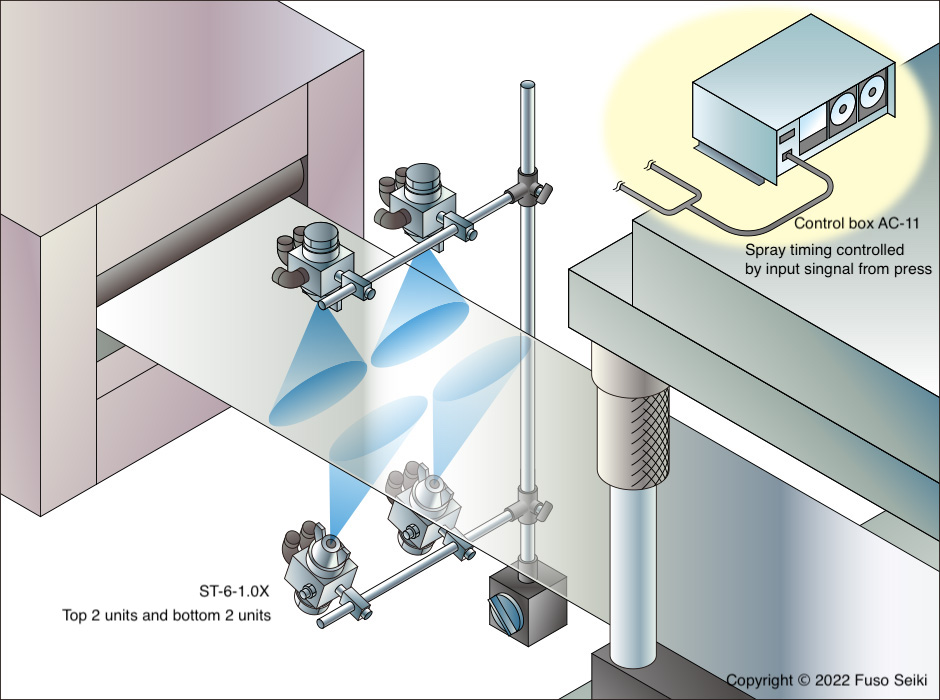
Lumina’s proposal and result
We proposed the standard ST-6-1.0X, which excels at applying stamping lubricant. Since the customer wanted to apply lubricant to the sheet from one end to end, we installed a total of four units, two on the top and two on the bottom.
- (Spraying conditions)
-
- Atomizing air pressure: 0.07 MPa
- Liquid pressure: 0.08 MPa
- Target distance: 130 mm
This made it possible to apply just the right amount of lubricant and eliminate excess on workpieces. In addition, this reduced the amount of lubricant used by 20-30%, resulting in a significant savings in annual operating costs.
Example 2
- User
- Digital camera parts manufacturer
- Application
- Lubricating oil for sheet metal
- Model used
- ST-6-0.5X, ST-6R-1.0X-C8-1.1-150L-90-H
Problem
This manufacturer uses metal stamping to form thin sheets 20-40 mm wide on a compact 45-ton press. The sheets were typically formed without lubricant because they were thin copper sheets. However, they have started to use stainless steel, meaning they need to use lubricant.
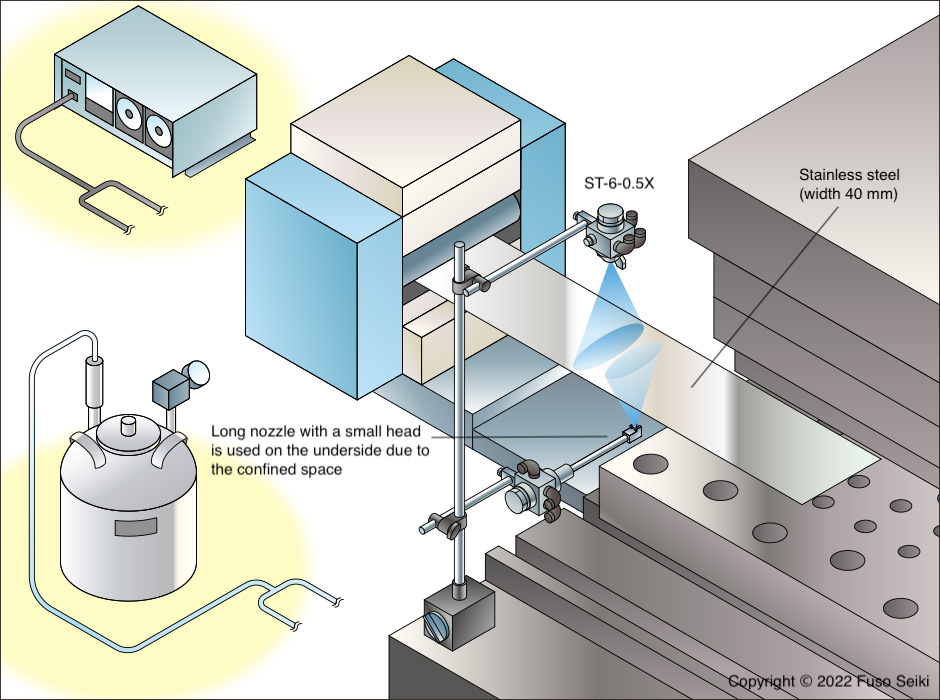
Lumina’s proposal and result
When mounting a spray gun on a press, it naturally must be positioned so that it does not interfere with the up and down motion of the slide or with the operator’s movements. In addition, it is not uncommon to find that there is insufficient space due to the many pieces of equipment placed around it. In such cases, a long nozzle with a compact head is effective.
In this case, we used the ST-6-0.5X, which excels at applying stamping lubricant, on the top as there was sufficient space. On the bottom, we used the ST-6R-1.0X-C8-1.1-150L-90-H, a long nozzle spray gun with a 90-degree spray due to the confined space.
- (Spraying conditions)
-
- Atomizing air pressure: 0.02 MPa
- Liquid pressure: 0.02 MPa
- Target distance: 40 mm
The atomizing air pressure was set low to 0.02 MPa due to the low viscosity of the lubricant and its tendency to diffuse into a mist easily. This made it possible to apply lubricant to sheets without getting the surrounding dirty.
Example 3
- User
- Chassis production for OA equipment
- Application
- Press forming
- Model used
- PR-40-2.0X
Problem
This manufacturer uses press forming to manufacture 500 mm x 450 mm chassis for OA equipment such as copy machines and multifunction printers.
Applying a coat of press lubricant (kinematic viscosity 15 mm²/s at 40℃) over this wide area was giving them trouble.
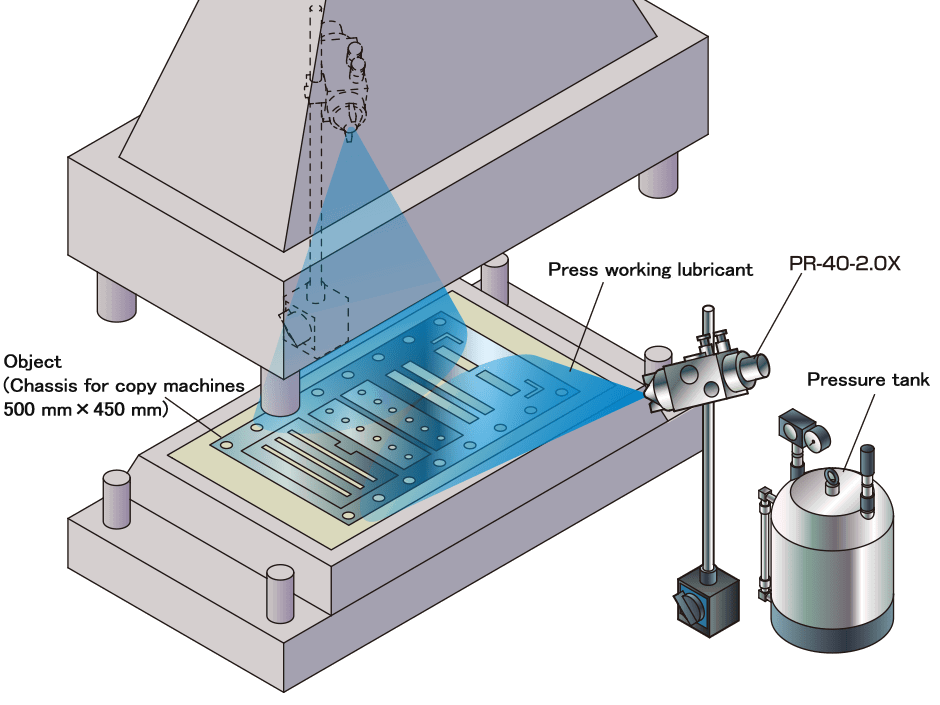
Lumina’s proposal and result
Since installation space was limited, we suggested a PR-40-2.0X for its ability to coat over a wide angle with a single spray gun. We looked for a way to spray lubricant horizontally over the press plate being conveyed to the manufacturing point from two points, one in front of the press and one behind it.
- (Spraying conditions)
-
- Atomizing air pressure: 0.05 MPa
- Pattern air pressure: 0.1 MPa
- Target distance: 300 mm
- Liquid supply: Pressure feed tank
As a result, damage to the objects manufactured was decreased compared to when the lubricant was insufficient, improving yield. We succeeded at increasing productivity.
Example 4
- User
- Building materials manufacturer
- Application
- Lubrication by needle nozzle in confined spaces
- Model used
- Specially-made HM-6LX
Problem
This building materials manufacturer uses a 150-ton press to stamp structural fittings. The press incorporates a special tapping unit that allows tapping (threading) to be performed simultaneously with the press process. However, the heat from the process easily ruins the tap, and they looked for a way to lubricate and cool the tap.
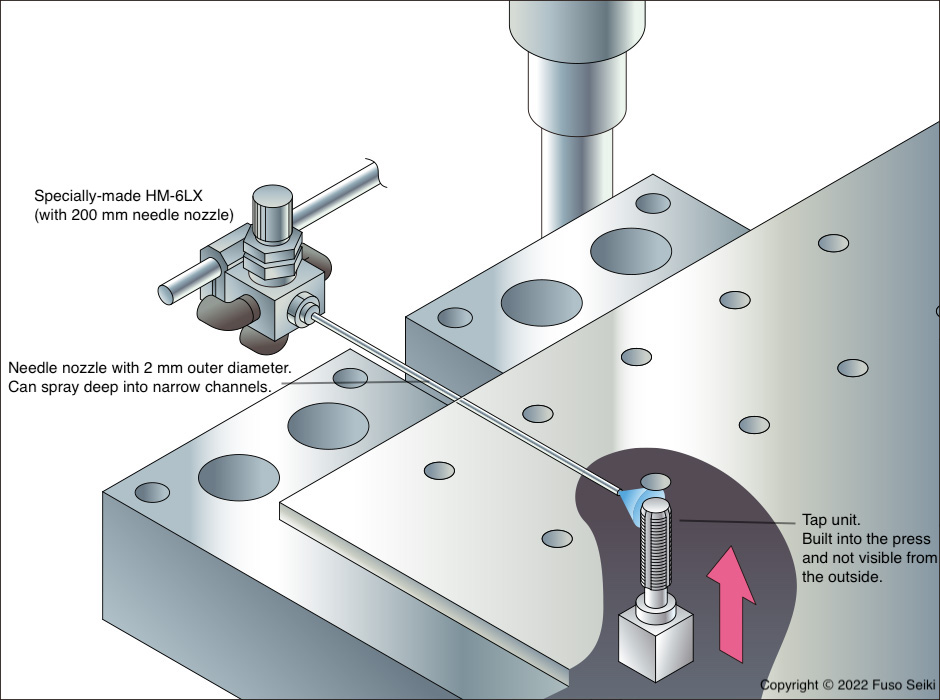
Lumina’s proposal and result
The tapping unit is built into the interior of the press. Since the tap is only exposed to the outside for a moment during processing, applying oil was extremely difficult in this case. As such, we used the specially-made HM-6LX with a 2 mm diameter 200 mm long needle nozzle (the needle nozzle for the standard product is 100 mm). A notch was made in the die, and by passing the needle nozzle through this gap, lubricant could be sprayed directly onto the tap inside the press machine.
- (Spraying conditions)
-
- Atomizing air pressure: 0.2 MPa
- Liquid pressure: 0.08 MPa
- Target distance: 30 mm
In this case, we wanted to lubricate the tap as well as cool it at the same time, so we set the atomizing air pressure higher. A stronger spray means a greater cooling power. Spraying the tap with a cold mist suppressed any softening and deformation of the tap, extending its life by 25%.
Example 5
- User
- Paint shop
- Application
- Chain lubrication
- Model used
- Magic Cut EM2-AT-Z60A (round magnet type)
Problem
This paint shop uses a chain conveyor as transport equipment. In the past, the chain was lubricated manually by an operator, but the operator often forgot to lubricate the chain, causing it to run out of oil and shortening the life of the chain.
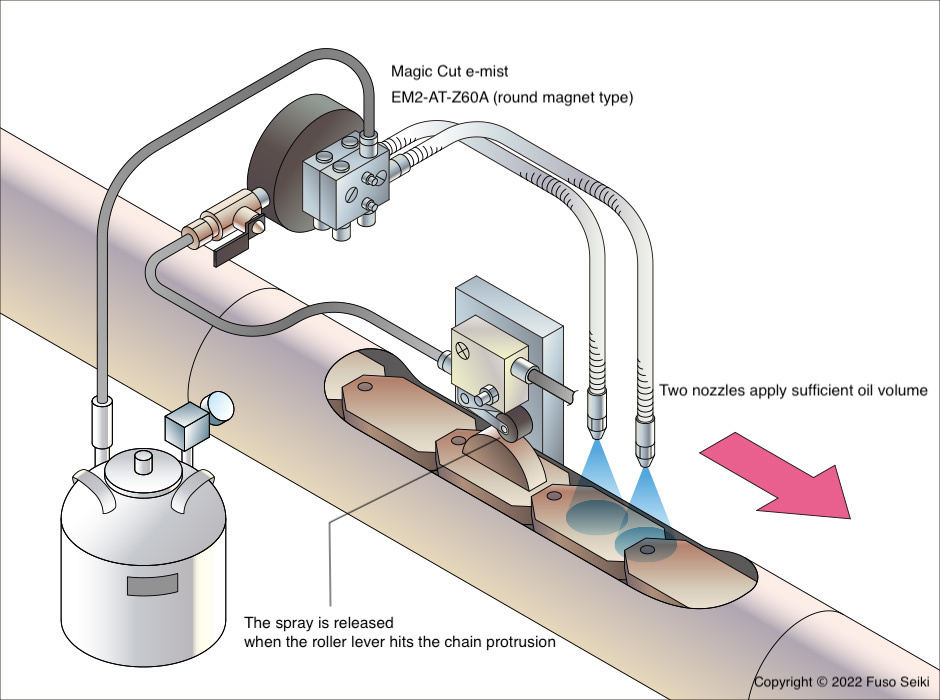
Lumina’s proposal and result
In this case, we used Magic Cut (round magnet type) with a flexible long nozzle. This device is used to cool and lubricate the cutting blade during cutting, but by changing the air cap to an optional short air nozzle, it can also be used for lubrication only.
A pneumatic roller lever valve is used to control the spray on/off. Spray is released when the roller lever contacts the protruding part of the chain. The atomizing air is set to a narrow spray to prevent the lubricant from scattering. Since a single nozzle does not provide sufficient oil volume, we used a twin (two units linked) specification with two nozzles.
- (Spraying conditions)
-
- Atomizing air pressure: 0.05 MPa
- Liquid pressure: 0.05 MPa
- Target distance: 40 mm
Properly lubricating the chain has resulted in longer chain life and reduced equipment replacement costs. Operators are also freed from the task of lubricating the chain, allowing them to concentrate on their core duties.

